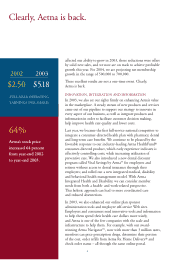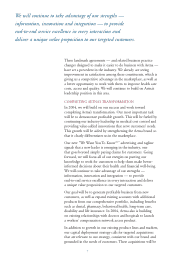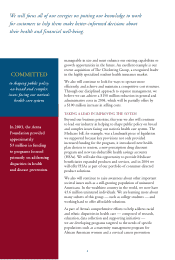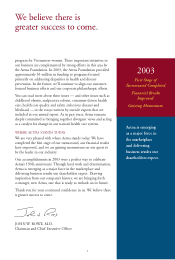Aetna 2003 Annual Report Download - page 15
Download and view the complete annual report
Please find page 15 of the 2003 Aetna annual report below. You can navigate through the pages in the report by either clicking on the pages listed below, or by using the keyword search tool below to find specific information within the annual report.
13
The epidemic of overweight and
obesity threatens to undo much
of our progress in public health
of the 20th century relative to
chronic diseases. In our report
we said, “Left unabated,
overweight and obesity may
soon cause as much preventable
disease and death as cigarette
smoking.” This epidemic must
not be left unabated; we must
respond in at least five settings
as outlined in detail in the
Call to Action. These include
schools, home/community,
work sites, health care and
media. Health care providers
must identify overweight and
obesity in children as not only
concerns but problems, and
prescriptions for changed
behavior must be written.
The epidemic of
overweight and
obesity threatens to
undo much of
our progress in
public health of the
20th century.
In December 2001, we released the Surgeon General’s
Call to Action to Prevent and Decrease Overweight and Obesity.
In defining overweight and obesity as an epidemic, we were
on solid public health ground. An epidemic is an unusual
increase in the occurrence of a disease or health problem above
the expected. Nowhere is the obesity epidemic more apparent
than in our children.
Since 1980 there has been
a doubling of overweight
and obesity in children in
this country and an actual
tripling among adolescents.
This epidemic had a
disproportionate impact on
low socioeconomic minority
children, especially African
Americans and Latinos, but the
epidemic is real in all groups.
When examining the behavior
of our children with respect to
physical activity and nutrition,
there is no reason to think that
this epidemic will end soon.
The environment that we
have created for our children
encourages overeating and
makes it difficult to be
physically active on a regular
basis. Many of our homes and
communities encourage the
consumption of fast food and
support sedentary lifestyles.
Our schools no longer
require physical education for
grades K-12, as they struggle
to meet academic requirements
and expectations. Likewise our
schools are not encouraging the
development of habits of good
nutrition, whether in school
meals or vending machines.
The irony of this is that
children who experience good
nutrition and fitness perform
better academically.
The concern here is not about
aesthetics or the appearance of
children. The concern is about
the health of our children.
We know that overweight and
obese children will most likely
be overweight and obese adults.
We also know that obesity
significantly increases the risk
of chronic diseases such as
asthma, cardiovascular disease,
diabetes and cancers.
Confronting The Epidemic
Of Childhood Obesity
























